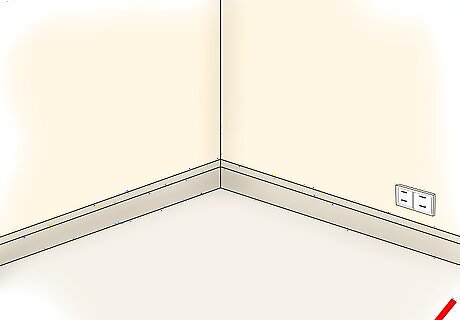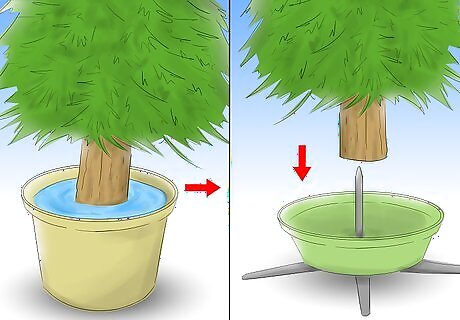
views
Picking a Good Tree

Choose a healthy tree. If at all possible, buy a Christmas tree from a tree farm, where you can purchase your tree while it's still in the ground. A freshly cut Christmas tree will last longer than one that's been cut weeks ago and shipped to distant retail outlets.

Steer clear of trees with a large number of dead or browning needles––these trees are already past their prime. Gently stroke a branch on the tree to make sure that the needles are flexible and remain on the tree.
Making Space in Your Home

Choose and clear a location for the tree. It should be kept away from open flames or heat sources, which may dry it out prematurely. Trees do sometimes burn so be careful (see Warnings below). Corners are good places to put trees because this placement keeps the tree safe from knocks and bumps. If you'll be using lights to decorate your tree, place the tree close to an outlet. If this isn't possible, you'll need to use an extension cord. Be sure that if you use an extension cord, it runs along to wall and doesn't create a trip hazard.Care for a Christmas Tree Step 3Bullet1.jpg

Cover the floor where the tree will be placed. You can use a properly sewn tree skirt or be budget savvy and use Christmas-themed paper or a piece of satin fabric as shown. This will not only serve decorative purposes, but it will also help protect the floor in case any water splashes out. If you have a skirt that goes over the cradle, you can still place a barrier underneath the cradle and apply the decorative skirt after the tree has been mounted. Not only does this make the tree more presentable but it prevents pets from attempting or wanting to drink the water in the base.
Mounting the Tree

Prepare the base of your tree. Using a small handsaw, cut about a half inch to an inch (1.3cm-2.5cm) off the bottom to aid water absorption. Note: It is recommended that you don't cut the base at an angle, in a V-shape or drill a hole in the base. None of these methods help water absorption and they may make it more difficult to hold the tree safely in the stand. DO NOT cut the tree with a reciprocating saw or any blade that moves so fast that it will create friction. If the cut gets hot enough, the sap in the tree will seal the end and make water absorption impossible. A chainsaw or manual saw will work.

Mount your tree within eight hours of cutting the base. That is how long a fresh tree can go without water before absorption is jeopardized. A Christmas tree should never be mounted dry. It is much better to place it in a container of water that is replenished on a regular basis. You can buy special tree cradles or stands which screw into the base of the tree and provide watering space. Or, you can go for the rougher but tried-and-true method of using a bucket filled with small rocks (put the tree in, fill the bucket with rocks around the trunk). The tree should be provided with 1 quart (950ml) of water for every inch (2.5cm) in trunk diameter. Note: ensure that whatever you use, the tree is stable. Don't whittle down the bark of the tree just so that it can fit in the stand - that outer layer is the part that absorbs the most water.

Make sure the tree is straight. It is a good idea for at least two people to put up the tree, one holding it stable while the other fixes the base. Always stand back to check that the tree is straight before you get busy decorating. Obviously, it is easiest to fix at this stage. Before decorating let the tree sit for a while to "settle" into its shape. Some suggest just an hour or so, others overnight.
Taking Care of the Tree

Water the tree. To start, you'll need to make sure your tree gets lots of water because in the first few hours that it's settling in, it will need plenty and will drink like crazy (possibly a full gallon/3.7 liters on the first day). (Also see Tips below.) Afterward, you will need to add water almost every day. A Christmas tree watering system increases the water capacity of your stand, provides a visual indication of your stand's water level and makes it easy to add water. NO crawling under the tree. No spilling water on your floor. Not only is regular water good for the tree's vitality, but a well-watered tree is less dry and therefore, less combustible. Make sure you never let the water level go below the base of the tree. Some people put an aspirin in the water to help keep it fresh. Some also add Ginger Ale, Sprite™ or another similar soda drink (fizzy lemonade) to feed their tree. Be careful, though; if you accidentally bump the can whilst watering the tree, you might end up with very sticky presents!

Check for sap leakage. It is a good idea to check occasionally for sap that has leaked from your tree onto nearby furnishings or floor coverings. The sooner you catch any sap leakages, the easier they are to remove.

Collect fallen pine needles. Use a dustpan and brush or a handheld vacuum (many needles going into a larger vacuum can easily clog it up; this may even break the machine, whereas a handheld version works well because you are obliged to keep emptying it as you work). This is a daily ritual, unless you want to have an enormous pile of needles to clean up when you finally move the tree. The needles are unsightly and potentially hazardous for curious pets and infants.Care for a Christmas Tree Step 11Bullet1.jpg A well-watered tree will lose fewer needles but all fresh trees will lose some needles.Care for a Christmas Tree Step 11Bullet2.jpg




















Comments
0 comment